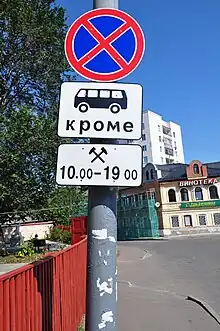
Road signs in Russia are governed by the traffic rules approved by the Decree of the Government of the Russian Federation No. 1090 of 23 October 1993 “On the Rules of the Road”, Appendix 1 “Road Signs”.[1] They are regulated by the ГОСТ Р 52289-2019[2] and ГОСТ Р 52290-2004[3] standards determining the rules for the use and production of road signs. The vast majority of road signs used in Russia were in the preceding Soviet standard ГОСТ 10807-78,[4][5] which was introduced in the Soviet Union on January 1, 1980 before its dissolution in 1991 and is no longer valid in Russia since January 1, 2006 after it was replaced by the modern standard ГОСТ Р 52290-2004 for road signs.[6] Road signs generally conform to the Vienna Convention on Road Signs and Signals. Similar road signs are also used in other post-Soviet states.
The state importance roads have different indexes, each stand for the respective letter of Cyrillic.[7]
| Index | Examples | Russian meaning | Meaning |
|---|---|---|---|
| M | Москва | The М index indicates roads connecting the capital city Moscow with other major cities of Russia | |
| P | Регион | The Р index indicates roads connecting cities between regions, but do not connect with Moscow | |
| А | — | The А index indicates roads leading to a major transport hub, railway, sea, river aviation, to a road border crossing. The А index also denotes roads connecting two federal highways | |
| E | Европейский | The E index indicates European routes passing through Russia | |
| AH | — | The AH index indicates Asian routes passing through Russia[8] |
The official typeface of road signs in Russian is specified in the ГОСТ Р 52290-2004 standard, formerly the ГОСТ 10807-78 Soviet standard. However, Arial is often used on road signs instead of one specified in the ГОСТ Р 52290-2004.
According to the ГОСТ Р 52290-2004 standard, modern road signs in Russia are divided into 8 categories:
| # | Category name | Category name (in Russian) |
|---|---|---|
| 1 | Warning signs | Предупреждающие знаки |
| 2 | Priority signs | Знаки приоритета |
| 3 | Prohibitory signs | Запрещающие знаки |
| 4 | Mandatory signs | Предписывающие знаки |
| 5 | Special regulations signs | Знаки особых предписаний |
| 6 | Information signs | Информационные знаки |
| 7 | Service signs | Знаки сервиса |
| 8 | Additional signs (plates) | Знаки дополнительной информации (таблички) |
History
The world's first road signs were approved at an international conference of motorists in 1909; among the participants were the Russian Empire. There were four road signs of that time and all of them were round: "uneven surface", "crossroads", "bends", and "railway crossing". New road signs and signals were officially adopted already in the USSR on December 1, 1927. In 1933, the number of road signs in the USSR was increased to 23 and they received the current shapes and colours, and for the first time they were divided into three categories: "warning", "prohibition" and "indicative". The following changes and additions regarding road signs were adopted on January 1, 1961, after the USSR joined the Geneva Convention on Road Traffic in 1959. The number of road signs has increased to 36. All signs received a yellow background. In 1968, the Convention on Road Traffic and Road Signs and Signals was created in Vienna. On November 8, 1968, the Soviet Union signed the Vienna Convention on Road Signs and Signals, and on June 7, 1974 ratified it.[9][10] The Vienna Convention on Road Signs and Signals was issued in all 6 official languages of the United Nations, including Russian, due to the fact that the Russian Federation (until December 1991 the Soviet Union) is a permanent member of the UN Security Council. New rules of the road, as well as road signs adopted by this convention, entered into force in the USSR in 1973. Subsequently, changes and additions to the rules of the road, road signs and signals were made in 1975, 1976, 1979, 1980, 1984 and 1987.[11]
Currently, the most common signs are made on a metal substrate covered with a reflective film. Signs that are illuminated around the perimeter or along the contour of the image of the sign, made using miniature incandescent lamps or LEDs, have become slightly widespread.
On January 1, 2006, the modern standard ГОСТ Р 52290-2004 for road signs was introduced in Russia, completely replacing the Soviet standard ГОСТ 10807-78.[6] New road signs were introduced in the ГОСТ Р 52290-2004 standard:
- Three new warning signs:
- A new prohibitory sign "Control" (Russian: Контроль) prohibiting passage without stopping at checkpoints is used instead of a stop sign.
- Images of mandatory signs "Turn right" (Russian: Движение направо) and "Turn left" (Russian: Движение налево) modified by replacing straight arrows used during the Soviet era with 90-degree ones. An approximately similar situation occurred in Belarus, when the standard СТБ 1140-99 was amended.
- A new category "Special regulations signs" (Russian: Знаки особых предписаний) with new road signs:
- "Number of lanes" (Russian: Число полос);
- "Restricted parking zone" (Russian: Зона с ограничением стоянки);
- "End of restricted parking zone" (Russian: Конец зоны с ограничением стоянки);
- "Regulated parking zone" (Russian: Зона регулируемой стоянки);
- "End of regulated parking zone" (Russian: Конец зоны регулируемой стоянки);
- "Maximum speed limit zone" (Russian: Зона с ограничением максимальной скорости);
- "End of maximum speed limited zone" (Russian: Конец зоны с ограничением максимальной скорости);
- "Pedestrian zone" (Russian: Пешеходная зона);
- "End of the pedestrian zone" (Russian: Конец пешеходной зоны).
- A new sign indicating general speed limits in Russia (Russian: Общие ограничения максимальной скорости) introduced.
- New service road signs "Reception area of a radio station transmitting traffic information" (Russian: Зона приема радиостанции, передающей информацию о дорожном движении) and "Radio communication area with emergency services" (Russian: Зона радиосвязи с аварийными службами) were introduced in connection with the development of mobile radio communications in Russia.
- New additional signs (tables) indicating various obstacles on the road (refuge islands, traffic islands, etc.).
In June 2018, in connection with the preparations for the 2018 FIFA World Cup in Russia, a new prohibition road sign "No buses allowed" (Russian: Движение автобусов запрещено) was introduced. This sign was used as a temporary sign from June 1 to July 17, 2018 during the 2018 FIFA World Cup and after the end of the World Cup, the sign was retired.[12][13] However, from March 1, 2023, this sign was reintroduced, but now on a permanent basis.[14] This is due to changes in the Rules of the Road in Russia that came into force on March 1, 2023, in particular, the speed limit for buses was introduced.[15]
In February 2019, the traffic police supported proposals for the introduction of reduced road signs, the idea was initiated by the Moscow government. They are planned to be installed throughout Russia after a successful experiment. The allowable size of signs will be reduced to 40 cm (16 inches) in diameter, and in some cases to 35 cm (14 inches), which is almost half the current standard of 60 cm (24 inches).[16]
On March 1, 2023, a new prohibition road sign "No personal mobility devices"[17] (Russian: Движение на средствах индивидуальной мобильности запрещено) was introduced.[18] It prohibits personal mobility devices such as electric scooters, electric skateboards, hoverboards, or segways. Earlier in October 2022, a similar sign prohibiting the movement of electric scooters was introduced in Belarus due to changes in the traffic rules of Belarus, which came into force on October 27, 2022.[19]
Warning signs
 Railway crossing with a barrier
Railway crossing with a barrier Railway crossing without a barrier
Railway crossing without a barrier Single-track railway
Single-track railway Multi-track railway
Multi-track railway Approaching a railway crossing
Approaching a railway crossing Approaching a railway crossing
Approaching a railway crossing Approaching a railway crossing
Approaching a railway crossing Approaching a railway crossing
Approaching a railway crossing Approaching a railway crossing
Approaching a railway crossing Approaching a railway crossing
Approaching a railway crossing Tramway crossing
Tramway crossing Intersection of equivalent roads
Intersection of equivalent roads Roundabout
Roundabout Traffic signals
Traffic signals Drawbridge
Drawbridge Exit to an embankment
Exit to an embankment Dangerous curve
Dangerous curve Dangerous curve
Dangerous curve Dangerous curves
Dangerous curves Dangerous curves
Dangerous curves Steep descent
Steep descent Steep ascent
Steep ascent Slippery road
Slippery road Rough road
Rough road Speed bump
Speed bump Gravel surface
Gravel surface Dangerous roadside
Dangerous roadside Road narrows ahead
Road narrows ahead Road narrows on the right
Road narrows on the right Road narrows on the left
Road narrows on the left Two-way traffic
Two-way traffic Pedestrian crossing
Pedestrian crossing Children
Children Bicycle path intersection
Bicycle path intersection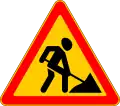 Roadworks
Roadworks Cattle
Cattle Wild animals
Wild animals Rockfall
Rockfall Crosswind
Crosswind Low-flying aircraft
Low-flying aircraft Tunnel
Tunnel Congestion
Congestion Other hazards
Other hazards Hazard chevron
Hazard chevron Hazard chevron
Hazard chevron Hazard chevron
Hazard chevron Hazard chevron
Hazard chevron Hazard chevron
Hazard chevron Hazard chevron
Hazard chevron Hazard chevron
Hazard chevron Hazard chevron
Hazard chevron Box junction
Box junction
Priority signs
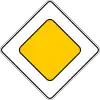 Priority road
Priority road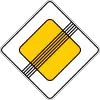 End of the priority road
End of the priority road Minor road four-way intersection
Minor road four-way intersection Minor road three-way intersection
Minor road three-way intersection Minor road three-way intersection
Minor road three-way intersection Minor road three-way intersection
Minor road three-way intersection Minor road three-way intersection
Minor road three-way intersection Minor road three-way intersection
Minor road three-way intersection Minor road three-way intersection
Minor road three-way intersection Give way
Give way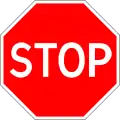 Stop
Stop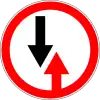 Priority of oncoming traffic
Priority of oncoming traffic Priority over oncoming traffic
Priority over oncoming traffic
Prohibitory signs
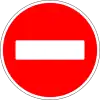 Entry prohibited
Entry prohibited Traffic prohibited
Traffic prohibited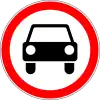 No motor vehicles
No motor vehicles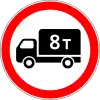 No lorries
No lorries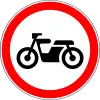 No motorcycles
No motorcycles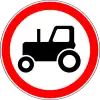 No tractors
No tractors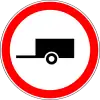 No vehicles with trailer
No vehicles with trailer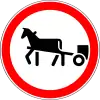 No horse-drawn carts
No horse-drawn carts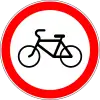 No cycling
No cycling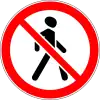 No pedestrians
No pedestrians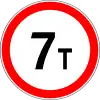 Vehicle weight limit
Vehicle weight limit Weight per axle limit
Weight per axle limit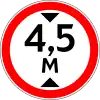 Height limit
Height limit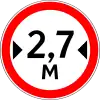 Width limit
Width limit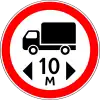 Length limit
Length limit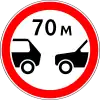 Minimum distance limit
Minimum distance limit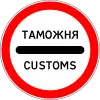 Customs
Customs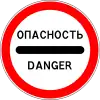 Danger
Danger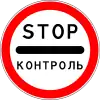 Control
Control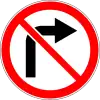 No right turn
No right turn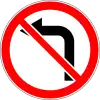 No left turn
No left turn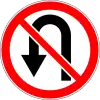 No U-turn
No U-turn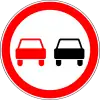 No overtaking
No overtaking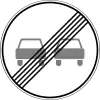 End of overtaking restriction
End of overtaking restriction No overtaking by lorries
No overtaking by lorries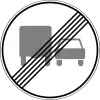 End of overtaking by lorries restriction
End of overtaking by lorries restriction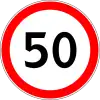 Maximum speed limit
Maximum speed limit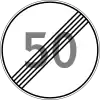 End of maximum speed limit
End of maximum speed limit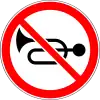 No beeping
No beeping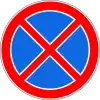 No stopping
No stopping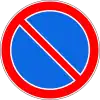 No parking
No parking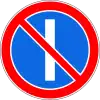 No parking on odd days of the month
No parking on odd days of the month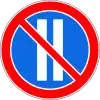 No parking on even days of the month
No parking on even days of the month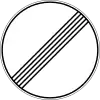 End of all restrictions
End of all restrictions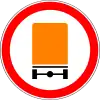 No vehicles with dangerous goods
No vehicles with dangerous goods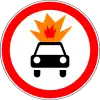 No vehicles with explosive and flammable loads
No vehicles with explosive and flammable loads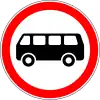 No buses
No buses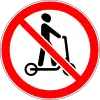 No personal mobility devices
No personal mobility devices
Mandatory signs
 Go straight
Go straight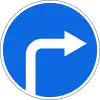 Go right
Go right Go left
Go left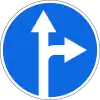 Go straight or right
Go straight or right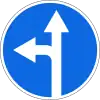 Go straight or left
Go straight or left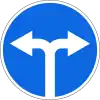 Go right or left
Go right or left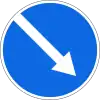 Detour on the right
Detour on the right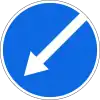 Detour on the left
Detour on the left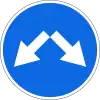 Detour on the right or left
Detour on the right or left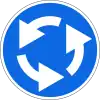 Direction of roundabout traffic
Direction of roundabout traffic
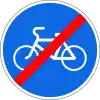 End of a cycle path
End of a cycle path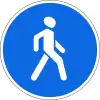 Footpath
Footpath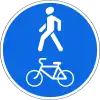
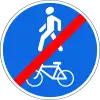 End of shared-use path
End of shared-use path Segregated pedestrian and cycle path
Segregated pedestrian and cycle path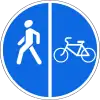 Segregated pedestrian and cycle path
Segregated pedestrian and cycle path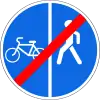 End of segregated pedestrian and cycle path
End of segregated pedestrian and cycle path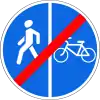 End of segregated pedestrian and cycle path
End of segregated pedestrian and cycle path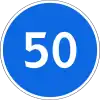 Minimum speed limit
Minimum speed limit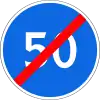 End of minimum speed limit
End of minimum speed limit Direction of movement of vehicles with dangerous goods
Direction of movement of vehicles with dangerous goods Direction of movement of vehicles with dangerous goods
Direction of movement of vehicles with dangerous goods Direction of movement of vehicles with dangerous goods
Direction of movement of vehicles with dangerous goods
Special regulations signs
 Motorway
Motorway End of motorway
End of motorway Road for cars
Road for cars End of road for cars
End of road for cars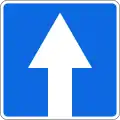 One-way road
One-way road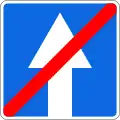 End of one-way road
End of one-way road Exit to a one-way road
Exit to a one-way road Exit to a one-way road
Exit to a one-way road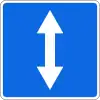 Reversible lane
Reversible lane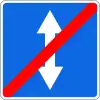 End of reversible lane
End of reversible lane Reversible lane
Reversible lane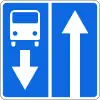 Road with a contraflow bus lane
Road with a contraflow bus lane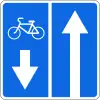 Road with a contraflow cycle lane
Road with a contraflow cycle lane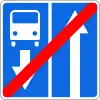 End of road with a contraflow bus lane
End of road with a contraflow bus lane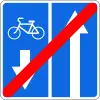 End of road with a contraflow cycle lane
End of road with a contraflow cycle lane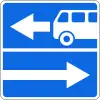 Exit to road with a contraflow bus lane
Exit to road with a contraflow bus lane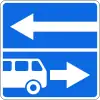 Exit to road with a contraflow bus lane
Exit to road with a contraflow bus lane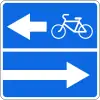 Exit to road with a contraflow cycle lane
Exit to road with a contraflow cycle lane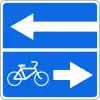 Exit to road with a contraflow cycle lane
Exit to road with a contraflow cycle lane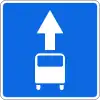 Bus lane
Bus lane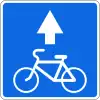 Cycle lane
Cycle lane End of bus lane
End of bus lane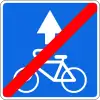 End of cycle lane
End of cycle lane Lane directions
Lane directions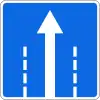 Lane directions
Lane directions Lane directions
Lane directions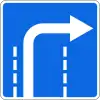 Lane directions
Lane directions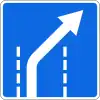 Lane directions
Lane directions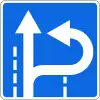 Lane directions
Lane directions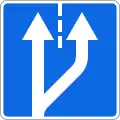 The beginning of the lane
The beginning of the lane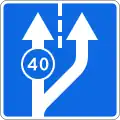 The beginning of the lane
The beginning of the lane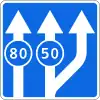 The beginning of the lane
The beginning of the lane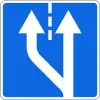 The beginning of the lane
The beginning of the lane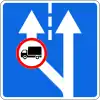 The beginning of the lane
The beginning of the lane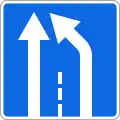 End of the lane
End of the lane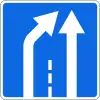 End of the lane
End of the lane Lane direction
Lane direction Lane direction
Lane direction Lane direction
Lane direction Number of lanes
Number of lanes Bus and/or trolleybus stop location
Bus and/or trolleybus stop location Tram stop location
Tram stop location Parking place for passenger taxis
Parking place for passenger taxis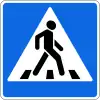 Pedestrian crossing
Pedestrian crossing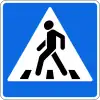 Pedestrian crossing
Pedestrian crossing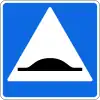 Speed bump
Speed bump Residential area
Residential area End of residential area
End of residential area Locality begins
Locality begins Built-up area begins
Built-up area begins End of locality
End of locality End of built-up area
End of built-up area Locality begins
Locality begins End of locality
End of locality No parking zone
No parking zone End of no parking zone
End of no parking zone Regulated parking zone
Regulated parking zone End of the regulated parking zone
End of the regulated parking zone Maximum speed limit zone
Maximum speed limit zone End of maximum speed limit zone
End of maximum speed limit zone Pedestrian zone
Pedestrian zone End of pedestrian zone
End of pedestrian zone Zone with restriction of ecological class of motor vehicles
Zone with restriction of ecological class of motor vehicles End of zone with restriction of ecological class of motor vehicles
End of zone with restriction of ecological class of motor vehicles Zone with restriction of ecological class of trucks
Zone with restriction of ecological class of trucks Zone with restriction of ecological class of trucks
Zone with restriction of ecological class of trucks End of zone restriction of ecological class of trucks
End of zone restriction of ecological class of trucks End of zone restriction of ecological class of trucks
End of zone restriction of ecological class of trucks Cycle zone
Cycle zone End of cycle zone
End of cycle zone
Information signs
 General maximum speed limits
General maximum speed limits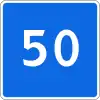 Recommended speed
Recommended speed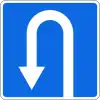 Place for a U-turn
Place for a U-turn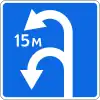 The area for a U-turn
The area for a U-turn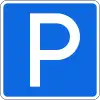 Parking (parking space)
Parking (parking space)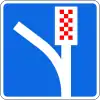 Emergency stop lane
Emergency stop lane Underground pedestrian crossing
Underground pedestrian crossing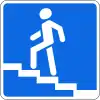 Above ground pedestrian crossing
Above ground pedestrian crossing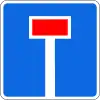 Deadlock
Deadlock Deadlock
Deadlock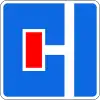 Deadlock
Deadlock Preliminary direction indicator
Preliminary direction indicator Preliminary direction indicator
Preliminary direction indicator Preliminary direction indicator
Preliminary direction indicator Preliminary direction indicator
Preliminary direction indicator Preliminary direction indicator
Preliminary direction indicator Preliminary direction indicator
Preliminary direction indicator Preliminary direction indicator
Preliminary direction indicator Preliminary direction indicator
Preliminary direction indicator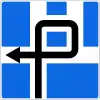 Traffic scheme
Traffic scheme Direction indicator
Direction indicator Direction indicator
Direction indicator Direction indicator
Direction indicator Direction indicator
Direction indicator Direction indicator
Direction indicator Direction indicator
Direction indicator Direction indicator
Direction indicator Name of the object
Name of the object Name of the object
Name of the object Name of the object
Name of the object Distance indicator
Distance indicator Distance indicator
Distance indicator Distance indicator
Distance indicator Kilometer sign
Kilometer sign Kilometer sign
Kilometer sign Kilometer sign (Rosavtodor)
Kilometer sign (Rosavtodor)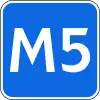 Route number
Route number Route number
Route number Route number
Route number Route number
Route number Route number
Route number Route number
Route number Route number
Route number Direction of movement for trucks
Direction of movement for trucks Direction of movement for trucks
Direction of movement for trucks Direction of movement for trucks
Direction of movement for trucks
 Detour scheme
Detour scheme Detour direction
Detour direction Detour direction
Detour direction Detour direction
Detour direction Preliminary index of the lane change to another carriageway
Preliminary index of the lane change to another carriageway Preliminary index of the lane change to another carriageway
Preliminary index of the lane change to another carriageway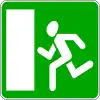 Emergency exit
Emergency exit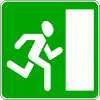 Emergency exit
Emergency exit Direction of movement to the emergency exit
Direction of movement to the emergency exit Direction of movement to the emergency exit
Direction of movement to the emergency exit Photovideofixation
Photovideofixation
Service signs
 Point of medical care
Point of medical care Hospital
Hospital Gas station
Gas station Vehicle maintenance
Vehicle maintenance Car washing
Car washing Phone
Phone Food point
Food point Drinking water
Drinking water Hotel or motel
Hotel or motel Camping
Camping Place of rest
Place of rest Traffic police post
Traffic police post Police
Police Transport control point
Transport control point Customs control point
Customs control point Reception area of a radio station transmitting traffic information
Reception area of a radio station transmitting traffic information Radio communication area with emergency services
Radio communication area with emergency services Pool or beach
Pool or beach Toilet
Toilet Emergency telephone number
Emergency telephone number Fire extinguisher
Fire extinguisher Gas station with possibility of charging electric vehicles
Gas station with possibility of charging electric vehicles
Additional signs (plates)
 Distance to the object
Distance to the object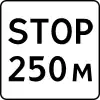 Distance to the object
Distance to the object Distance to the object
Distance to the object Distance to the object
Distance to the object Coverage area
Coverage area Coverage area
Coverage area Coverage area
Coverage area Coverage area
Coverage area Coverage area
Coverage area Coverage area
Coverage area Directions of action
Directions of action Directions of action
Directions of action Directions of action
Directions of action Type of vehicle
Type of vehicle Type of vehicle
Type of vehicle Type of vehicle
Type of vehicle Type of vehicle
Type of vehicle Type of vehicle
Type of vehicle Type of vehicle
Type of vehicle Type pf vehicle
Type pf vehicle Type of vehicle
Type of vehicle Type of vehicle
Type of vehicle Type of vehicle
Type of vehicle Except for the type of vehicle
Except for the type of vehicle Except for the type of vehicle
Except for the type of vehicle Except for the type of vehicle
Except for the type of vehicle Except for the type of vehicle
Except for the type of vehicle Except for the type of vehicle
Except for the type of vehicle Except for the type of vehicle
Except for the type of vehicle Except for the type of vehicle
Except for the type of vehicle Except for the type of vehicle
Except for the type of vehicle Saturdays, Sundays and holidays
Saturdays, Sundays and holidays Working days
Working days Days of the week
Days of the week Validity period
Validity period Validity period
Validity period Validity period
Validity period Validity period
Validity period Method of parking the vehicle
Method of parking the vehicle Method of parking the vehicle
Method of parking the vehicle Method of parking the vehicle
Method of parking the vehicle Method of parking the vehicle
Method of parking the vehicle Method of parking the vehicle
Method of parking the vehicle Method of parking the vehicle
Method of parking the vehicle Method of parking the vehicle
Method of parking the vehicle Method of parking the vehicle
Method of parking the vehicle Method of parking the vehicle
Method of parking the vehicle Parking with an idle engine
Parking with an idle engine Paid services
Paid services Limitation of parking duration
Limitation of parking duration Parking for parking permit holders only
Parking for parking permit holders only Parking of diplomatic corps vehicles only
Parking of diplomatic corps vehicles only Place for car inspection
Place for car inspection Limitation of the permitted maximum mass
Limitation of the permitted maximum mass Dangerous roadside
Dangerous roadside Direction of the main road
Direction of the main road Traffic lane
Traffic lane Blind pedestrians
Blind pedestrians Wet coating
Wet coating Disabled people
Disabled people Except for the disabled
Except for the disabled Dangerous goods class
Dangerous goods class Type of vehicle trolley
Type of vehicle trolley Type of vehicle trolley
Type of vehicle trolley Type of route vehicle
Type of route vehicle Type of route vehicle
Type of route vehicle Type of route vehicle
Type of route vehicle Obstacle
Obstacle Obstacle
Obstacle Obstacle
Obstacle Photovideofixation
Photovideofixation The tow truck is working
The tow truck is working Environmental class of the vehicle
Environmental class of the vehicle Charging electric vehicles
Charging electric vehicles
Experimental signs
 Right turn on red permitted
Right turn on red permitted
Similar systems
Similar road signs are used in most countries that formed after the collapse of the Soviet Union in 1991. Initially, the ГОСТ 10807-78 standard was adopted in the Soviet Union in 1980, but after its collapse in 1991, the same standard continued to operate in many post-Soviet countries until some of these countries adopted their own standard, in particular, in Russia, the ГОСТ Р 52290-2004 standard was adopted, in Ukraine ДСТУ 4100:2021, in Belarus СТБ 1140-2013, in Kazakhstan СТ РК 1412-2017, and in Uzbekistan O'zDst 3283:2017.[20] Road signs in Armenia and Kyrgyzstan are entirely based on the ГОСТ Р 52290-2004 and ГОСТ Р 52289-2004 Russian standards.[21][22] Inscriptions on road signs vary depending on the country's official language.
In Estonia and Latvia, road signs are outwardly different from the Russian ones. In Lithuania, road signs still bear a resemblance to those used in the Soviet Union, despite the fact that Lithuania restored its independence in 1990 and that the country joined the European Union in 2004. This is due to the fact that the Baltic states were occupied and later annexed by the Soviet Union in 1940 during the World War II.
References
- ↑ "Постановление Правительства РФ от 23.10.1993 N 1090 "О Правилах дорожного движения" (ПДД) (последняя редакция) (вместе с "Основными положениями по допуску транспортных средств к эксплуатации и обязанности должностных лиц по обеспечению безопасности \ КонсультантПлюс". www.consultant.ru. Retrieved 2023-11-16.
- ↑ "ГОСТ Р 52289-2004 Технические средства организации дорожного движения. Правила применения дорожных знаков, разметки, светофоров, дорожных ограждений и направляющих устройств" (PDF). joldo.kg (in Russian).
- ↑ "Скачать ГОСТ Р 52290-2004 Технические средства организации дорожного движения. Знаки дорожные. Общие технические требования". meganorm.ru (in Russian). Retrieved 2023-03-25.
- ↑ "Межгосударственный стандарт ГОСТ 10807-78 "Знаки дорожные. Общие технические условия" (утв. постановлением Госстандарта СССР 30.08.1978 N 2401) (с изменениями и дополнениями) (не действует) | ГАРАНТ". base.garant.ru (in Russian). Retrieved 2023-03-20.
- ↑ "Скачать ГОСТ 10807-78 Знаки дорожные. Общие технические условия". meganorm.ru (in Russian). Retrieved 2023-03-25.
- 1 2 "Дорожные знаки по ГОСТу Р 52290-2004 (от 14.12.2005)". www.sevdorstroy.ru (in Russian). 2005-12-14. Retrieved 2023-11-14.
- ↑ Макров, Антон (2021-07-13). "Что обозначают буквы в названии автомобильных трасс". CAR.RU (in Russian). Retrieved 2023-08-04.
- ↑ "МЕЖПРАВИТЕЛЬСТВЕННОЕ СОГЛАШЕНИЕ ПО СЕТИ АЗИАТСКИХ АВТОМОБИЛЬНЫХ ДОРОГ" (PDF). United Nations (in Russian). 6 January 2024. Retrieved 6 January 2024.
- ↑ "Как менялась Венская конвенция о дорожном движении". Коммерсантъ (in Russian). 2018-09-08. Retrieved 2023-06-26.
- ↑ "В помощь: Дорожные знаки Фотографии старого Саратова" (in Russian). Archived from the original on 2015-04-13. Retrieved 2015-04-09.
- ↑ "В помощь: Дорожные знаки | Фотографии старого Саратова" (in Russian). Archived from the original on 2015-04-13. Retrieved 2015-04-09.
- ↑ "Знак движение автобусов запрещено для чемпионата мира по футболу". pddmaster.ru. Retrieved 2023-08-26.
- ↑ "С сегодняшнего дня в России появился временный дорожный знак Движение автобусов запрещено". www.garant.ru. Retrieved 2023-08-26.
- ↑ FEIP. "Новые ПДД для автобусов с 1 марта 2023". Профи Центр (in Russian). Retrieved 2023-08-26.
- ↑ "Ограничение скорости автобусов и другие изменения в ПДД в 2023 году — ТрансАвто-7 на vc.ru". vc.ru. 2023-06-21. Retrieved 2023-08-26.
- ↑ "Дорожные знаки меньшего размера появятся по всей России" (in Russian). www.kommersant.ru. 2019-02-04. Archived from the original on 2019-02-04. Retrieved 2019-02-04.
- ↑ A personal mobility device is a vehicle that has one or more wheels, intended for the individual movement of a person using an engine. (electric scooters, electric skateboards, hoverboards, Segways, unicycles, and other similar devices)
- ↑ "Движение на самокате запрещено: в России ввели новые дорожные знаки". Моя планета (in Russian). 2023-03-01. Retrieved 2023-11-16.
- ↑ "Новые знаки в ПДД с 27 октября: смотрите, чтобы быть в курсе". Новости Бреста и Брестской области сегодня | БрестСИТИ. 2022-10-26. Retrieved 2024-01-11.
- ↑ "IndorRoadSigns: Система проектирования дорожных знаков". www.indorsoft.ru. Retrieved 2023-07-19.
- ↑ "ԳՕՍՏ Ռ 52290-2004". armstandard.am (in Armenian).
- ↑ "Мэр Омуркулов встретится с гражданским активистом Баратовым - Вести.kg - Новости Кыргызстана". vesti.kg (in Russian). 2013-08-19. Retrieved 2023-07-19.